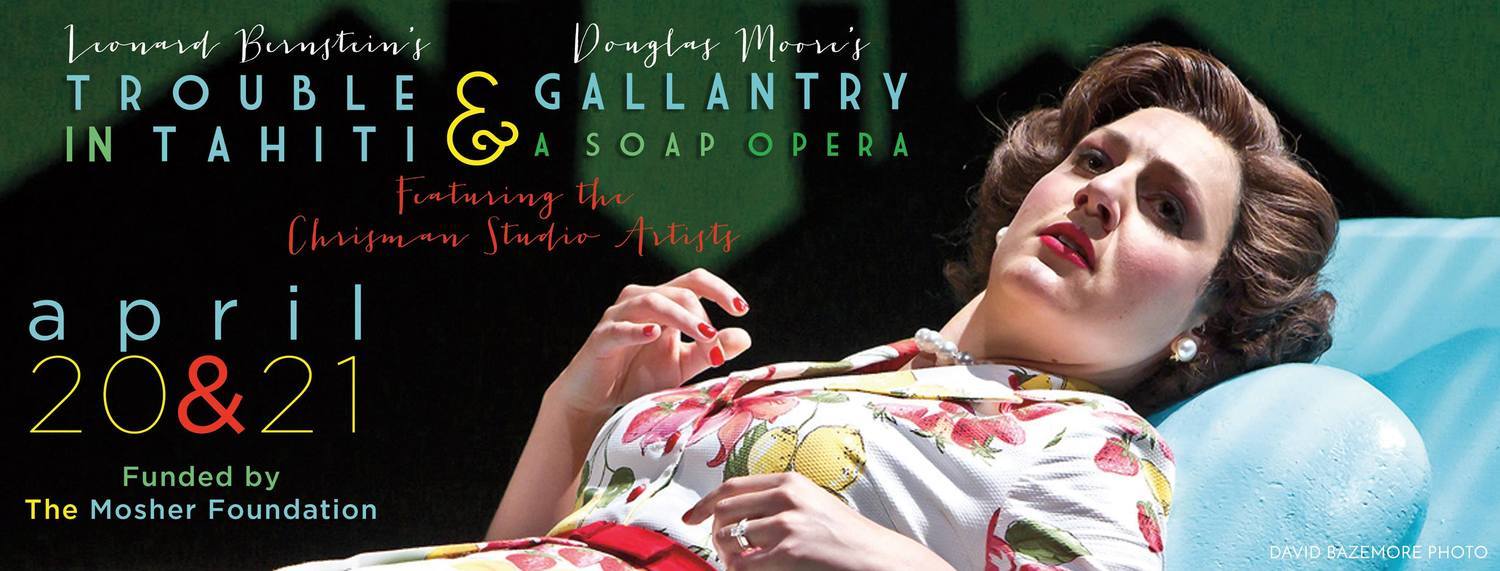Review: GALLANTRY AND TROUBLE IN TAHITI at Center Stage

On April 21, 2018, Opera Santa Barbara presented Douglas Moore's GALLANTRY and Leonard Bernstein's TROUBLE IN TAHITI at the Center Stage Theater in downtown Santa Barbara. The Center Stage is a 130-seat black box auditorium on the third floor of the chic, user-friendly Paseo Nuevo.
The program opened with the presentation of material on the two short operas and the chance to discuss them with fellow operagoers over wine and cheese. A few audience members had seen TROUBLE IN TAHITI. No one had seen or heard GALLANTRY.
GALLANTRY, which premiered in 1958 in New York at Columbia University, has a libretto by Arnold Sundgaard and was seen on television in 1962. Unfortunately, the tiny gem of an opera has been almost completely dormant since. It's less than 30 minutes in length, so it does not fill half an evening, but there are other short operas with which it could be combined into an entertainment of three or four mini-operas.
Moore wrote GALLANTRY two years after his hit show, THE BALLAD OF BABY DOE. Like Pietro Mascagni and Ruggiero Leoncavallo, the composers of Cavalleria Rusticana and Pagliacci, Moore remains famous for only one opera.
Television announcer Chelsea Melamed had been hired to advertise Lochinvar Soap, a product she says does not even make suds. However, when the camera is on her she tells of its wonderful properties. When the camera is off, she complains. She does not want to wear the Lochinvar dress and hat, either, but she allows herself to be dressed in them to keep her job.
Chelsea is a talented comedian with fine timing, which enabled her to draw myriad laughs from the audience. In between Chelsea's commercials, there were scenes from a melodramatic soap opera sung as a real opera. Strong-voiced soprano Elle Valera was a dramatic Nurse Lola Markham while baritone Byron Mayes was an energetic and commanding Doctor Gregg. The doctor made a pass at Lola but she was only interested in her lover, Donald, played by the verismo-voiced Jonathan Walker VanKuren, who happened to be their current patient.
After some contrived situations that would not be acceptable to even the least able soap opera writer, the dramatic cast would have to wait for another day and give the rest of the air time to the commercial. It was all great fun and gave four of Opera Santa Barbara's Chrisman Studio Artists the opportunity to show their not inconsiderable talents.
After a pleasant intermission, which gave audience members the chance to congregate and chat in an outer area of the Paseo, the program continued with TROUBLE IN TAHITI, the only show for which Bernstein wrote his own libretto. Bernstein premiered it at Brandeis University in 1952 and it appeared on television the same year.
Chelsea Melamed and Byron Mayes played Sam and Dinah, an unhappily married couple who could not express their feelings adequately. We will always wonder if this story tells of private moments in Bernstein's childhood. Perhaps he turned to music because there was unease in the atmosphere at home.
The composer solved the onstage situation with a lively vocal trio. Bernstein referred to them as "A Greek chorus born of the radio commercial." Singing close harmony were Elle Valera, Jonathan Walker-VanKuren and Vincent Grana and they made sure there were no dull moments. For most of the time they sang in a dance band style, but they also did some scat singing in between Sam and Dinah's arias and attempts at dialogue.
The trio was completely charming when they sang of familiar suburban towns as they were in the early fifties. Bernstein dedicated the work to Marc Blitzstein, a good friend, and he intended it to satirize "the good life" and materialism in the suburbs of that era.
Few of the people who made up last night's audience were alive in the 1950s, so the audience looked at it as interesting history that was enlivened by music from its time. The life and work of Leonard Bernstein, too, is now history that contains important cultural lessons to be learned by later generations.
If there is one lesson that we can learn from Leonard Bernstein, it is that an evening's entertainment can contain several different styles of music. Thanks to the virtuosity of Pianist and Music Director Kyle Naig, the stylistic changes were well integrated and the tempi were brisk. These two rarely seen operas proved to be an excellent choice for a balmy Saturday evening in Santa Barbara.
Add Your Comment
Videos
